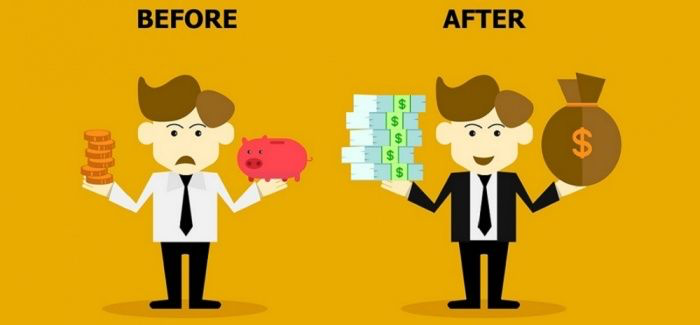By the time I became a top performer at Yelp, consistently closing 300% — 400% of my monthly quota, I no longer wondered if deals were going to come in. They started coming naturally to me. A prospect’s “yes” or “no” was clear just minutes into the conversation. Of course, sales don’t come so easily to everyone. Walking the sales floor, I overheard numerous sales styles, the good and the ugly, and I observed some obvious mistakes. By the time I left Yelp, I’d come to realize the problem wasn’t isolated — it was ubiquitous. Sales are accomplished throughout a conversation, starting with gaining trust with a straightforward “non-salesy” introduction, through active listening in the qualification process, aligning your solutions with stated needs, and a direct closing value proposition which outlines the impact they will realize by partnering with you, financial or otherwise.
Many sales newbies believe that closing deals happens at the end of the conversation, after they walk a potential client through the benefits of a service and pricing. They get excited that they are able to get this far into the conversation without the prospect becoming disinterested. At this point in the conversation, many novice or underperforming sales professionals are unsure if the answer will be “yes,” without realizing that there should have already been a series of “yeses,” through aligning deliverables and needs, to create momentum toward a positive outcome.
Salespeople with more experience and a consistent track record learn to avoid surprises by building momentum throughout the conversation. Whereas, the novice believes the very nature of progressing to the close is a win. In reality, it’s often a polite prospect patiently waiting to say no.
Here are some tips to help cut down on surprises and get you to yes:
Close from the start, not the end.
Creating partnerships happens throughout the entire deal-making process, including prospecting, outreach, qualifying, discovery, product/service features and benefits overview, outlining the value a prospect derives, and pricing. If you fail anywhere along the way, your sale — and, more devastatingly, your relationship — is over. Make sure that you are reaching out to the right organizations that will see value in your product or service. Get in touch with decision-makers and understand the their decision-making process, including pain points, urgency, budgets, and timelines for new solutions.
Handle objections as you go along.
A common sales mistake is to ignore objections — as if pretending not to hear them will make them go away. Well, these objections are coming up for a reason. Potential buyers want to buy valuable products that can help them make or save money. These objections may be serious concerns they have about your product or service not suiting them or they just simply may need more education on the value a partnership will provide. If you don’t pay attention, then there won’t be a deal. Instead, listen to the objection and ask again what they are trying to accomplish. Ask them why the goal is important, and what financial and other impact needs to be delivered. Assuming there is a fit, align your deliverable with their need. If not, move on to the next opportunity. Even hesitancy or boredom in someone’s voice is an objection, and you need to get to the bottom of it. If you sense doubt, call it out!
Don’t be right, be smart.
Instead of proving you are right, ask clients leading questions that can help them reach your conclusion on their own. It’s much easier to close a deal when the client is using their own words to tell you why your solution is going to provide them value. Have them sell themselves.
I was speaking with a salon prospect in an area of New Hampshire. The prospect and the area were both new to online advertising. In past conversations, I had stated that online advertising works because customers are searching for similar businesses online — but logically going through benefits was not helping the prospect see value in our services. By asking about her customers’ online and mobile habits, how they find businesses, and how they decided where to spend money, her answers to my questions provided the value I was trying to convey. It became apparent that our services made sense and it was in her own words, not mine. This allowed us to come to an agreement.
Be a human, have fun, build relationships.
No one likes overly tense or aggressive salespeople. Sales can be one of the most fun professions out there. You get to constantly meet new people and help them solve problems — some of my clients are good friends. Not only are we working together now, but we are building lifelong value outside of the office. These relationships can last through job changes and new ventures. And they aren’t just about the current solution; it is a test on how much value we can build over the course of our relationship to see if we should work together more comprehensively in the future.
Going to work when this is the case is extremely rewarding. Make sure you have a good time out there and remain relentlessly positive. By building long-term value in your relationships, you will gain credibility with your prospects and their contact network. Over time, this will help you close more deals, make more friends, and help you lead a better and more fulfilling life.
I was speaking with a travel consultancy prospect who had been burned by online advertising in the past — it hadn’t worked and left a bad taste in his mouth — so there was very little trust in restarting the conversation. I took time to educate this client, addressing his concerns and offering him relevant information to prove that ads had worked for similar businesses. Educating instead of selling. We agreed to walk before we ran and slowly prove the product’s power and potential over time — building long-term trust. He finally agreed to a pilot of a few hundred dollars per month and that partnership grew into several hundred thousand dollars per year. Our agreement to work together was the spark and kindling, which grew over time into a fire. How long that fire burns is up to us and how we continue to foster our relationship.
Ask for the close and then ask again.
In my experience, people usually say “no” three times before they say “yes”. The biggest problem I see with salespeople is that they don’t ask for the deal. The second biggest is that they don’t ask again. The reason people say “no” is because they don’t see value. They don’t believe or understand how they will arrive at the expected level of ROI, or other significant impact, that will justify a decision to move forward. Almost any other reason aside from a financial impact in most scenarios is secondary. Keep probing to better understand and qualify if the need you are addressing can be solved with your product or service, and if doing nothing at all to address a prospect’s problem is acceptable. If you follow the rest of the tips in this article, the transition from discussion to agreement should flow naturally.
And if it still doesn’t work, on to the next one.
Not every prospect will be sold. It happens. A quick disqualification is valuable for both you and your prospect, and again it’s the lifetime value of your relationships that matter most. People genuinely appreciate when you value their time as much as your own. One of the only things you can control is how long it takes for you to stop feeling sorry for yourself and start having the next conversation. As Zig Ziglar says, “It’s not how far you fall, but how high you bounce that counts.”
Originally published at medium.com


